So you’re in the market for a used vehicle with all-wheel drive (AWD) or four-wheel drive (4WD). As we write this, in the middle of a typical Ontario winter, we can’t say we blame you.
It doesn’t matter whether you’re commuting on Toronto’s crowded Highway 401 or you regularly travel the Trans-Canada between Sudbury and Sault Ste. Marie: An SUV, a crossover utility or a car with AWD or 4WD can be a great antidote to winter traction-related frustration.

While AWD and 4WD basically do the same thing – improve traction by powering all four wheels – they do it in different ways. Before you buy, we thought it might be helpful to know what distinguishes AWD from 4WD, and which vehicles have which type of system.
What is AWD?
Today, AWD is the more common of the two types of drive layout. Typically, AWD is an option in vehicles that come standard with front-wheel drive. Even with AWD, these cars, crossovers and SUVs operate in front-wheel mode most of the time.

- It’s only when the front wheels spin that the AWD system automatically directs some power to the rear axle to help get the car moving. Once underway, however, the car reverts to front-wheel drive.
- This basic type of AWD system is a staple of the SUV and crossover utility segments. For example, the subcompact Mazda CX-3, compact Volkswagen Tiguan, mid-size Hyundai Santa Fe and full-size Chevrolet Traverse all have AWD.
Not all AWD system are equal
Nevertheless, not all AWD systems are the same, even on different vehicles from the same company. For example, Mercedes-Benz markets all of its AWD systems as 4MATIC, but how the system works depends on the vehicle. In the GLA-Class compact crossover, for example, it works as we described above. Only the front wheels are powered until they spin, and then the system automatically engages the rear axle.
- In the brand’s larger vehicles, from the C-Class sedan to the full-size GLS-Class SUV, the 4MATIC AWD system always drives all four wheels. If the wheels on the front or rear axle start to spin, more power is sent the other way.
- AWD can also be used to boost performance on dry roads. Like most AWD systems, the Acura Super Handling AWD (SH-AWD) system can send about half the engine’s power to the rear axle. This happens in vehicles like the TLX sedan, RDX and MDX SUVs. But in enthusiastic driving, SH-AWD can direct more power to the outside rear wheel when accelerating through a turn, improving the vehicle’s high-speed handling.
- If you’re interested in an AWD vehicle, you’ve probably heard of Subaru. The Japanese company makes AWD standard in most of its models, including the Impreza compact car and the Forester and Outback SUVs. Subaru’s AWD system is rare among economy cars and mainstream SUVs in that it powers all four wheels all the time.
What is 4WD?
Four-wheel drive is most commonly found in pickup trucks such as the Ford F-150, large SUVs like the Chevrolet Tahoe and the Jeep Wrangler SUV. Generally speaking, 4WD is better in challenging off-road situations than AWD.

- Typically, these vehicles run in rear-wheel drive until the driver engages 4WD mode manually. An electronic dash-mounted dial is the most common way of doing so. In some vehicles, like the Jeep Wrangler, they may have a second shift lever for the 4WD system.
- Whatever the type of controller, it will usually have selections for two-wheel drive, 4WD high and 4WD low. The 4WD low uses a special set of gears to increase engine torque for challenging off-road driving.
- One of the most important distinctions between these 4WD systems and the AWD setups discussed earlier is that 4WD is not meant to be used on clear, dry roads. That’s because engaging 4WD locks the front and rear axles together, which is useful on slippery surfaces. But using 4WD on dry pavement can damage the system. That’s because it doesn’t allow the front and rear axles to turn at different speeds when steering around a corner.
- To confuse things, some 4WD vehicles (usually only those with an electronic selector) have an automatic full-time 4WD setting, too. That means you can leave the system on all the time, even on dry roads, and it will work more like AWD.
Which one is right for you?
If you do most of your driving in the city, where snowy, icy roads are your biggest concern, then a fully-automatic AWD system will do the trick. The vast majority of AWD vehicles will also work well on the muddy or gravel roads you might drive to access a cottage or campground.
But if you are interested in serious off-road driving, you will want to get a 4WD vehicle. These systems are built to stand up to rugged terrain that will literally stop some AWD vehicles in their tracks.
Do your research first
If you’re looking for true 4WD capability, do you research to make sure the car manufacturer isn’t using the 4WD label as a marketing tool. For example, some older versions of the Toyota RAV4 and Honda CR-V have “4WD” badges. However, these popular compact SUVs are actually AWD and not built for challenging off-roading.


